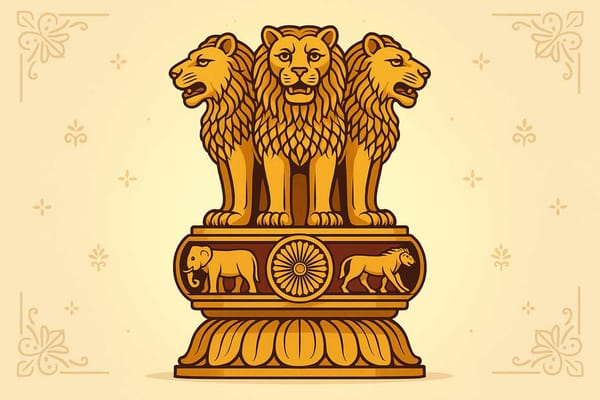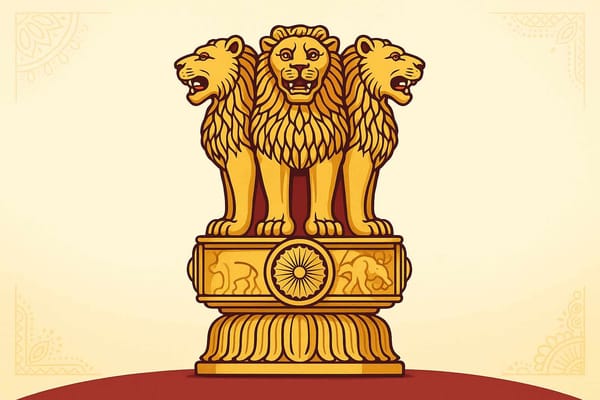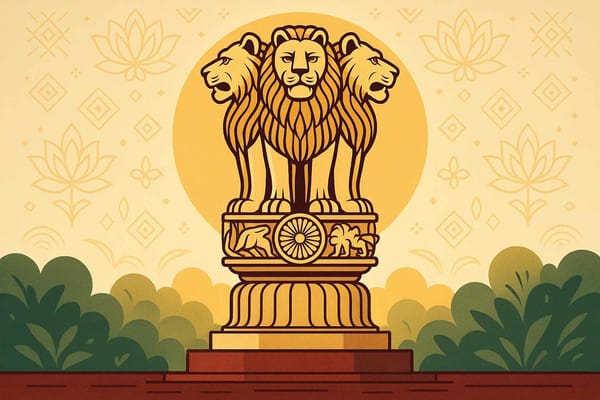
The Symbolism and Significance of the Lion Capital of Ashoka: Meaning Explained
Every time we look at our currency, our passports, or any official government document, a majestic and silent symbol greets us. Four lions, standing back-to-back, strong and serene. Have you ever paused and truly wondered about the story behind this powerful emblem? It's not just a design; it’s a whisper from our past, a message that has travelled through more than two millennia to reach us. This is the story of the Lion Capital of Ashoka, a symbol deeply woven into the fabric of India's identity.
This journey takes us back to around 250 BCE, to the ancient city of Sarnath. It was here that Emperor Ashoka, a ruler whose life story is one of the most profound transformations in history, erected a pillar crowned with this magnificent sculpture. Today, it stands not just as a relic in a museum but as our National Emblem, a constant reminder of our strength, our heritage, and the values we hold dear.
A King's Change of Heart: The Story Behind the Pillars
To understand the Lion Capital, we must first understand the man who commissioned it. Emperor Ashoka of the Maurya Empire was once a fierce conqueror. But the brutal Kalinga War changed him forever. The sight of immense suffering and loss broke his heart, leading him to a path of peace and compassion. He embraced Buddhism and dedicated the rest of his reign to spreading Dharma—the principles of righteousness, morality, and ethical governance.
But how could he share his message with every person in his vast empire? Ashoka's solution was ingenious and heartfelt. He erected towering stone pillars across the land, each inscribed with his teachings, guiding his people towards a virtuous life. The pillar at Sarnath was especially significant, for it was at this very place that Lord Buddha delivered his first sermon after attaining enlightenment, setting the 'Wheel of Dharma' in motion.
Decoding the Masterpiece: More Than Just Stone and Polish
The Lion Capital is a marvel of ancient Indian art, a sculpture where every single element is rich with meaning. It's like reading a sacred text written in the language of symbols. Let's look closer at its design.
- The Four Majestic Lions: Many often wonder what these four lions, seated back-to-back, truly represent. They are far more than just symbols of royal power or courage. They are roaring, but their roar is not one of aggression. It is the roar of Dharma, spreading the Buddha's message of truth and peace in all four directions. They stand as vigilant guardians, representing the universality of these timeless principles and the nation's confidence and pride.
- The Circular Abacus and its Animals: Below the lions rests a circular drum, or abacus, beautifully carved with four animals: a galloping horse, a sturdy bull, a swift elephant, and another powerful lion, separated by wheels. These animals are not random. They are believed to represent the four stages of Lord Buddha's life or the four cardinal directions, symbolizing a journey and the cyclical nature of existence. They tell a story of energy, stability, and courage working in harmony.
- The Dharma Chakra (The Wheel of Law): The wheel, or 'Ashoka Chakra', is perhaps the most recognized element, now gracing the centre of our national flag. It’s a powerful symbol of the 'Wheel of Dharma'. Its 24 spokes represent righteousness, forward movement, and the eternal laws of the universe. It reminds us that as a nation, we must always move forward, but our progress must be guided by moral and ethical principles.
- The Inverted Lotus Base: The entire capital rests on a beautifully sculpted, inverted lotus flower. In our culture, the lotus is a profound symbol of purity and spiritual awakening. It grows in muddy waters yet blossoms into a thing of pristine beauty. This represents the ability of truth and enlightenment to rise above the challenges and complexities of worldly life. The incredible skill used to create these pillars is a testament to the advanced architectural knowledge of ancient India, a legacy you can explore further in the Echoes of Divinity: India's Temple Architecture.
From an Ancient Pillar to a Modern Nation's Identity
It’s no surprise, then, that when the time came to choose a national emblem for a newly independent India on January 26, 1950, our founding fathers looked back to this powerful symbol. Why was the Lion Capital chosen? Because it perfectly encapsulated the values of the nation we aspired to build. A nation that is strong but compassionate, courageous but committed to peace, and forever moving forward on the path of justice and truth.
Today, its presence on our official seals, currency, and government buildings signifies the authority and integrity of the Republic of India. It’s a promise of accountability and a reminder of the deep-rooted ideals that guide us. The emblem connects the ancient legacy of Ashoka with the aspirations of modern India, bridging past, present, and future.
Preserving a Priceless Legacy
If you ever wish to see this magnificent piece of history with your own eyes, the original Lion Capital is carefully preserved at the Sarnath Museum, near Varanasi in Uttar Pradesh. Seeing it in person is a truly moving experience. While the Sarnath pillar is the most famous, it's worth remembering that Ashoka erected many such pillars across India, each a silent testament to his vision. The rich symbolism found in such artifacts is a core part of our festive and cultural celebrations, something we delve into in our piece on Celebrating Indian Festivals.
The Lion Capital of Ashoka is more than just an artifact; it is the soul of India cast in stone. It is a timeless symbol that speaks of resilience, unity, and moral responsibility, inviting us all to live by the noble values it represents.
About Us
At Bhaktilipi, we believe that understanding these deep-rooted symbols is a spiritual journey in itself. We are dedicated to preserving and sharing devotional literature and stories that help you connect deeply with India's rich traditions. Our platform is a space to explore profound topics like the Symbolism and Significance of the Lion Capital of Ashoka, making our incredible cultural heritage accessible to everyone.
Stay updated with more insights on devotion, culture, and heritage by subscribing to our newsletter or following our journey on social media:
Facebook | Instagram | YouTube
Let’s preserve tradition together!
A passionate group of people dedicated to preserving India's knowledge of Dharma, Karma, and Bhakti for ourselves and the world 🙏.
Comments
Related in

Lion Capital of Ashoka-India's Heritage Explained
Have you ever held a coin in your hand or looked at your passport and truly seen the four lions seated majestically back-to-back? It’s a sight so familiar to us Indians, a part of our daily lives. But this isn't just a design; it's a

The Historical Significance of the Lion Capital of Ashoka: Understand its Enduring Legacy
There are some symbols that are etched into the very soul of a nation. For us in India, the Lion Capital of Ashoka is one such powerful emblem. We see it on our currency notes, on our passports, and on every official government letterhead. But have you ever paused to

The Significance of the Lion Capital of Ashoka: Explores Indian History
Have you ever paused for a moment, holding a currency note or looking at your passport, and truly looked at the four lions standing so majestically? That symbol, the Lion Capital of Ashoka, is something we see almost every day. But how often do we think about its story? It’
